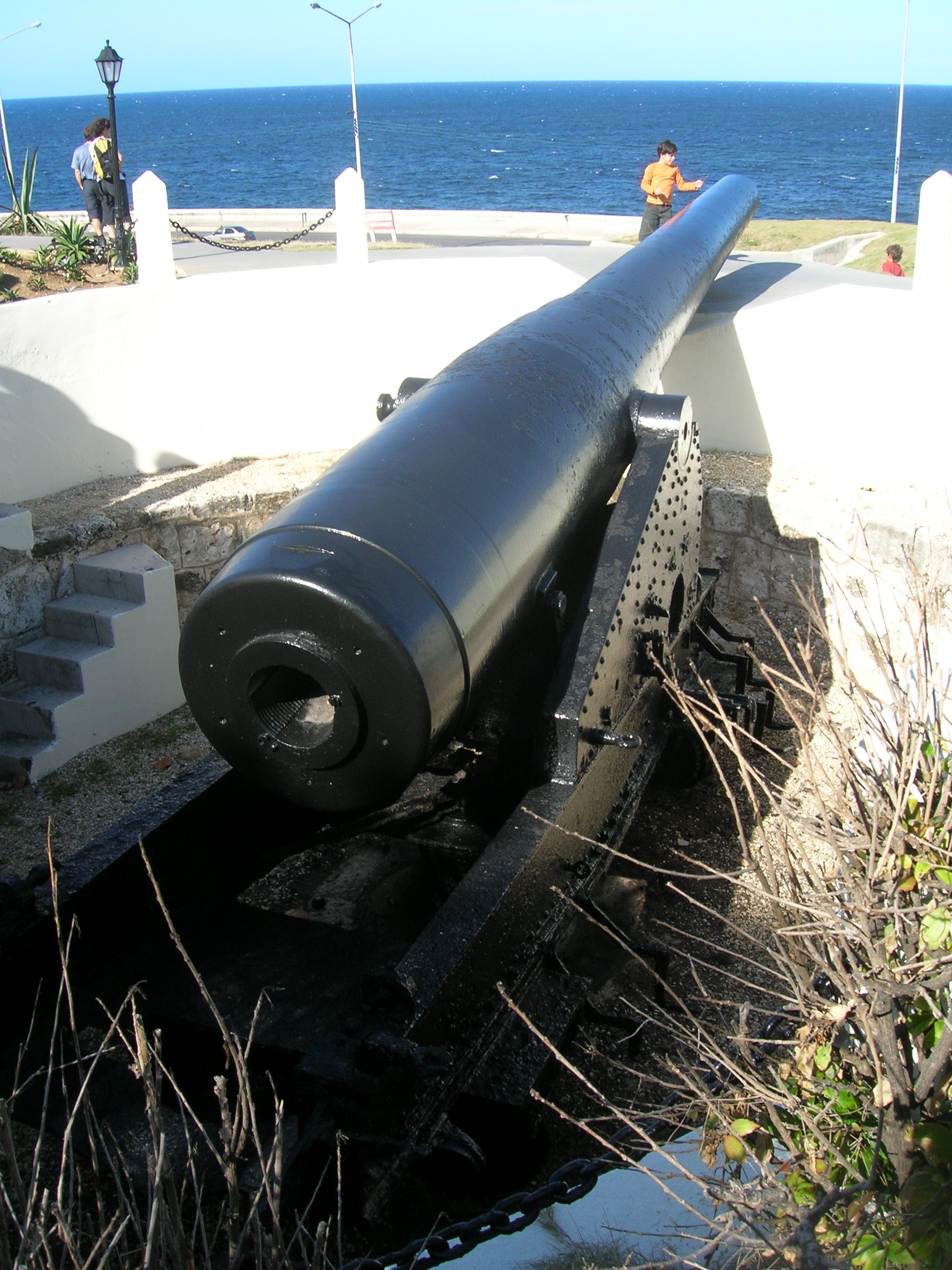Santa Clara Battery on:
[Wikipedia]
[Google]
[Amazon]
 The Santa Clara Battery, with its two remaining
The Santa Clara Battery, with its two remaining
 The first battery on this site was built between 1797 and 1799, and was named for
The first battery on this site was built between 1797 and 1799, and was named for
File:View of Batería de Santa Clara (Santa Clara Battery) in Havana, Cuba.jpg, View of Battery of Santa Clara
Battery of Santa Clara areal. Havana, Cuba.jpg, Battery of Santa Clara
 The Santa Clara Battery, with its two remaining
The Santa Clara Battery, with its two remaining coastal guns
Coastal artillery is the branch of the armed forces concerned with operating anti-ship artillery or fixed Artillery battery, gun batteries in coastal fortifications.
From the Middle Ages until World War II, coastal artillery and naval artillery ...
, one a caliber 305mm (12") Ordóñez HSE Modelo 1892 rifle and the other a 280mm (11") Krupp
The Krupp family (see pronunciation), a prominent 400-year-old German dynasty from Essen, is notable for its production of steel, artillery, ammunition and other armaments. The family business, known as Friedrich Krupp AG (Friedrich Krup ...
, stands on the grounds of the Hotel Nacional de Cuba
The Hotel Nacional de Cuba is a historic Spanish eclectic style hotel in Havana, Cuba, opened in 1930. Located on the sea front of Vedado district, it stands on Taganana Hill, offering commanding views of the sea and the city.
History
Design ...
, in Vedado
Vedado ( es, El Vedado, ) is a central business district and urban neighborhood in the city of Havana, Cuba. Bordered on the east by Calzada de Infanta and Central Havana, and on the west by the Alemendares River and Miramar / Playa distric ...
, Havana
Havana (; Spanish: ''La Habana'' ) is the capital and largest city of Cuba. The heart of the La Habana Province, Havana is the country's main port and commercial center.
. UNESCO in 1982 included the battery, together with Old Havana
Old Havana ( es, link=no, La Habana Vieja) is the city-center (downtown) and one of the 15 municipalities (or boroughs) forming Havana, Cuba. It has the second highest population density in the city and contains the core of the original city of ...
, in its list of UNESCO World Heritage sites. There is a small museum featuring the 1962 Cuban Missile Crisis
The Cuban Missile Crisis, also known as the October Crisis (of 1962) ( es, Crisis de Octubre) in Cuba, the Caribbean Crisis () in Russia, or the Missile Scare, was a 35-day (16 October – 20 November 1962) confrontation between the United S ...
in the battery. During the crisis, Fidel Castro
Fidel Alejandro Castro Ruz (; ; 13 August 1926 – 25 November 2016) was a Cuban revolutionary and politician who was the leader of Cuba from 1959 to 2008, serving as the prime minister of Cuba from 1959 to 1976 and president from 1976 to 200 ...
and Che Guevara
Ernesto Che Guevara (; 14 June 1928The date of birth recorded on /upload.wikimedia.org/wikipedia/commons/7/78/Ernesto_Guevara_Acta_de_Nacimiento.jpg his birth certificatewas 14 June 1928, although one tertiary source, (Julia Constenla, quoted ...
set up their headquarters there to prepare the defense of Havana from aerial attack. The museum is in tunnels there known as the ''Cueva Taganana'' (Taganana Cave), for the hill on which the battery stands.
Overview
Juan Procopio Bassecourt y Bryas
Juan Procopio de Bassecourt Thieulaine y Bryas López de Ochoa, (22 April 1740 – 12 April 1820) was Baron of Maials, Count of Santa Clara an office he assumed before the Spanish Cession enacted by the Adams-Onís Treaty of 1819, Captain Gen ...
, Count of Santa Clara, the Spanish governor of Cuba from 1796 to 1799. The battery was modernized in 1895, when it received new guns. It was armed with three 11" Krupp and two 12" Ordóñez guns, as well as two Nordenfelt
The Nordenfelt gun was a multiple-barrel organ gun that had a row of up to twelve barrels. It was fired by pulling a lever back and forth and ammunition was gravity fed through chutes for each barrel. It was produced in a number of different ...
6-pounder quick firing gun
A quick-firing or rapid-firing gun is an artillery piece, typically a gun or howitzer, which has several characteristics which taken together mean the weapon can fire at a fast rate. Quick-firing was introduced worldwide in the 1880s and 1890s an ...
s for close-in defense. There were also some leftover older, obsolete pieces, including eight 8" howitzers, which may have been 210mm (8.3") ''sunchado'' howitzers.
On 7 May 1898, during the Spanish–American War
, partof = the Philippine Revolution, the decolonization of the Americas, and the Cuban War of Independence
, image = Collage infobox for Spanish-American War.jpg
, image_size = 300px
, caption = (clock ...
, the Spanish lured the USS ''Vicksburg'' and the US Revenue Cutter into chasing a Spanish schooner under the guns of the battery. The battery fired too soon on the US vessels, which were able to escape without taking a hit. Then on 13 June the Krupp gun fired on the protected (armored) cruiser USS ''Montgomery'' at a range of 9000 meters,Plaque on the site of the gun. also without effect.
Following the Spanish–American War, US troops were billeted there and later a barracks was constructed, which was torn down in 1928 or 1929 to provide a site for the hotel.
Gallery
See also
* Batería de la de la ReinaReferences
{{DEFAULTSORT:Santa Clara battery Coastal fortifications Spanish colonial fortifications in Cuba Fortifications of Havana Artillery batteries